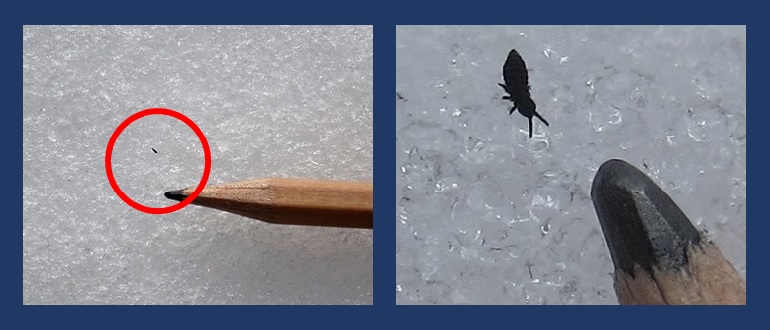A Tiny Circus in the Snow
GET TO KNOW Snow Fleas (a.k.a. Springtails)
Snow fleas come out on warmer winter days to frolic in the snow.
FUN FACT: Tiny, little snow fleas provide many positive ecosystem benefits. As decomposers, they eat dead plant/animal matter and contribute to healthy, nutrient rich soil. Additionally, they are believed to help protect plant roots by munching up harmful bacteria and fungi while also distributing beneficial bacteria/fungi. So, here is a big thank you to the snow fleas!
Flinging themselves hither and yon, they spring through the air like miniature aerialists. Often, thousands of these tiny creatures gather on the snow where they tumble about in the world’s smallest flying circus. You can view a video of them here!
Since individual snow fleas average only 1/16th of an inch long, it is not surprising when they go unnoticed. For, even though they are dark in color, a good-sized crowd of snow fleas may appear as nothing more than a sprinkling of dirt on the white snow. Only close inspection reveals their aerial antics.
Since snow fleas are creatures of the soil, the purpose of their winter acrobatics seems unclear. Are they seeking warmth in the sun? Are they finding bits of food in the snow? Or are they engaging in energetic mating rituals? Opinions vary, and only a snow flea knows for sure.
But please, don’t be alarmed by the misleading “flea” nickname, for these little critters are not fleas at all. They do not bite, and they do not eat growing plants. They cause no harm whatsoever. Rather, they are quite beneficial little creatures and great, good fun to watch.
HABITAT AND LIFE CYCLE
Snow fleas are not true insects. Instead, they are members of the Collembola taxonomic class. Collembola is a very large class with several thousand member species found throughout the world. All are tiny, wingless hexapods (having 6 legs) that require moist conditions to survive. As a group, they are commonly called “springtails” because they often travel by catapulting themselves through the air with the help of a spring like appendage known as a furcula.
The furcula is normally tucked up tight on the underside of the abdomen but can be released like a spring to slap the ground and fling the little bug through the air. From general observation, it appears that springtails can fling themselves distances of several hundred times their own body length. It is also believed that they have little, if any control over the trajectory of launch and are, therefore, at the mercy of fate. So why do springtails fling themselves in random directions? Perhaps it is a startle reflex or a defensive strategy. Perhaps it is part of the mating and courtship ritual. Or perhaps it is just plain fun. Only a springtail knows.
Of all the types of Collembola, two specific species – Hypogastrura harveyi and Hypogastrura nivikola – frolic in the winter snow and are, therefore, nicknamed snow fleas. Their tiny bodies produce specific amino acids (with high levels of glycine) that prevent ice crystals from growing within individual cells. These snow fleas are freeze avoidant – meaning they are able to remain active and healthy without freezing in the cold. (Note: this winter survival strategy differs from the freeze tolerant mourning cloak butterfly. Mourning cloaks also produce special proteins to survive, but the butterfly survives in a partially frozen diapause state of rest.)
Tiny snow fleas (hypogastrura) are omnivores and serve as important decomposers of decaying plant and animal matter. They are primarily found in forest environments where many tens of thousands of individuals may inhabit a single square meter of soil. Most of the time, they crawl about within the soil and leaf litter of the forest floor. The exact nature of their life cycle is not well documented, but it is known that they do not go through a distinct immature phase, but rather hatch directly from egg to miniscule adult-looking form and undergo a large number of molts (shedding of exoskeletons) as they grow.
TAKE ACTION
Snow fleas, as decomposers, are necessary components of a healthy environment. Healthy soil is an extremely valuable natural asset that is comprised of a complex mix of both biotic and abiotic materials. Biotic materials are living/decaying materials such as plants, tiny creatures, fungi, and bacteria while abiotic materials include bits of minerals, air, and water. (Healthy soil is important for the proper regulation of the hydrologic, carbon, nitrogen, and sulfur cycles in our environment.) It is therefore very important to protect the many tiny creatures who live in – and produce – our valuable soil.
Unfortunately, snow fleas are susceptible to many common home/garden pesticide products. All too often, these little critters are labeled as household “pests” and specifically targeted by exterminators.
You can help protect snow fleas, and other tiny members of our ecosystem, by pledging to have a pesticide free home and yard. For more information, see our page at Protecting the Rouge
Spread the word that snow fleas are good guys and help FOTR protect even the tiniest citizens of our watershed.
MAIN PHOTO CREDIT: Snow Flea (Hypogastrura harveyi or Hypogastrura nivikola) by Charles de Mille-Isles CC-BY-2.0 – cropped
